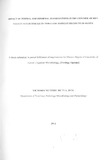| dc.description.abstract | Rift Valley fever (RVF) is an arthropod borne disease, transmitted by Aedes mosquitoes, which was first reported in Naivasha area of Rift Valley Province of Kenya in 1912, but the , virus was isolated and recognised later in 1931. It is a disease of domestic livestock and wild ruminants. It is zoonotic causing hemorrhagic fevers in humans. RVF is endemic in many African countries including Kenya. In Kenya various studies have been done regarding RVF. They include: the presence of the virus and its serotype, presence of the transmitting vectors, the host range and also if the disease is present in wild life or not. Recently a study was done in North Eastern Kenya to evaluate the inter-epidemic and sero-positivity ofRVF virus. Another study was also done in the same region in 2007 to assess the socio - economic impacts of the disease where it was shown that the communities were affected.
The communities targeted in these studies were mainly the pastoralist as the disease is reported to be occurring more in these areas than other parts of the country. However, little is known about the disease in dairy farming communities. There is little that is known about the knowledge capacity of the farmers regarding RVF, thus there was need to find out if these communities had indigenous knowledge relevant to various aspects of the disease and its control. The study assessed the farmers' knowledge of the disease, its risk factors, various traditional management practices and their perception on the formal control measures instituted by the government. These control measures include vaccinations, quarantine, closure of markets and ban of sale, slaughter and consumption of animals. The study took place in two areas, one a pastoral community in Marigat District in the Rift Valley province and the other a dairy farming community in Thika District in Central Province. From these two study sites, the study aimed at assessing the impacts and effectiveness of the control measures put up during the recent outbreaks both the formal, government instituted , and informal, traditional methods; and also assess the risk factors to RVF outbreaks. The data was collected using questionnaires, interviews and group discussions with more information being obtained from the government offices.
The data was then analyzed using Statistical Package for Social Sciences (SPSS). Although farmers from both sites knew about the disease, those in Marigat were more aware having experienced the disease outbreak in their livestock and family members than those in Thika. According to the farmers this was a relatively new disease and they did not have well defined traditional methods of predicting, managing or controlling the disease. They relied on the treatment and control options provided by the government. They also did not have a traditional name for the disease. The disease and the control options instituted by the government against R VF impacted on the social, cultural and economic activities of the communities more in Marigat and these included: loss in income interference to their social and cultural ceremonies including circumcisions, weddings, 'oloibon' (rain makers) ceremonies and gatherings for various reasons as these required the slaughter of animals as part of the ceremony.
Marigat had more risk factors to the spread of the disease than Thika. These risk factors included the terrain with presence of depressions that would collect water during heavy rainfall, 'dambos', the major breeding grounds for the Aedes mosquito leading to increase in number of the disease transmitting vector, handling of the infected animals and most farmers treating the sick animals exposing themselves to infection and slaughtering their animals for various ceremonies. This involved them handling the infected carcasses and some consuming the meat leading to spread of the infection.ignorance about the disease transmission dynamics could have been an added risk factor. | en_US |

